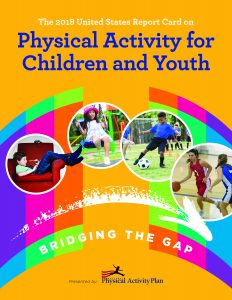By National Physical Activity Plan Alliance
With approximately 24% of children 6 to 17 years of age participating in the recommended 60 minutes of physical activity every day, the United States earned a D- in Overall Physical Activity the newly released 2018 U.S. Report Card on Physical Activity for Children and Youth.
 The 2018 U.S. Report Card on Physical Activity for Children and Youth, developed by the National Physical Activity Plan, assesses the levels of physical activity and sedentary behaviors in American children and youth. The Report Card examines nine indicators of physical activity, including facilitators and barriers for physical activity, and health outcomes related to youth physical activity. This year’s Report Card is the third comprehensive assessment of physical activity in U.S. children and youth, updating the first Report Card released in 2014 and second released in 2016.
The 2018 U.S. Report Card on Physical Activity for Children and Youth, developed by the National Physical Activity Plan, assesses the levels of physical activity and sedentary behaviors in American children and youth. The Report Card examines nine indicators of physical activity, including facilitators and barriers for physical activity, and health outcomes related to youth physical activity. This year’s Report Card is the third comprehensive assessment of physical activity in U.S. children and youth, updating the first Report Card released in 2014 and second released in 2016.
The Report Card was developed by the Report Card Research Advisory Committee, which includes experts in diverse areas of physical activity and health behaviors from academic institutions and partner organizations across the country. Using the Global Matrix 3.0 from the Healthy Active Kids Global Alliance as a framework, the Committee identified nationally representative surveys and assigned letter grades for each of the 9 indicators:
| Indicator | Grade |
| Overall Physical Activity | D- |
| Sedentary Behaviors | D |
| Active Transportation | D- |
| Organized Sport Participation | C |
| Active Play | INC |
| Physical Fitness | C- |
| Family and Peers | INC |
| School | D- |
| Community and Built Environment | C |
Despite the poor grades the U.S. has seen some improvement since 2016 with upward movement in the grades for sedentary behavior, active transportation, organized sports participation, and physical fitness. “While these positive results are encouraging and provide a glimpse into what’s possible, there is no denying that the overall grades for the indicators remain critically low,” said Peter Katzmarzyk, chair of the Report Card Research Advisory Committee. “This Report Card should generate a renewed sense of urgency to take the action needed for the sake of our children and their future.”
The Report Card serves as both a comprehensive surveillance tool and an advocacy tool that provides accountability and a call-to-action for decision-makers regarding how parents, teachers, health professionals, community leaders and policy makers can implement new initiatives, programs and policies to improve the physical activity levels and health of children and youth. Following each grade the Report Card includes specific recommendations, supported by the National Physical Activity Plan and outside resources, which suggest paths for improvement.
The 2018 Report Card goes one step further to include information on 3 settings that are especially important for physical activity promotion and increasing activity levels of children:
- Government Strategies and Investment
- Faith-based Settings
- Early Childcare Settings
Although the committee did not assign grades for these settings, the information for these settings identifies opportunities for increasing activity levels and how these settings can be leveraged to improve the 9 indicator grades. A diversified and collaborative effort across settings can help to bridge the gaps so that the physical activity levels of all American children are increased!
To learn more about the U.S. Report Card on Physical Activity for Children and Youth and what you can do to improve the health of America’s children and youth, visit the NPAPA website or connect with NPAPA on social media through Facebook or Twitter.
Spread the Word! Share this post with your social network using this sample message: How active are American youth? Find out in the 2018 U.S. Report Card on #PhysicalActivity for Children and Youth from @NationalPAPlan in this blog post from @HHSPrevention #PAReportCard https://bit.ly/2OO9GiA